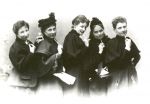Minna Cauer
‘Because I must and I will try to help the citizens to move to the
left.’
(Nancy Spoenemann, in berlin.de, February. 14, 2012)
Why do I think this woman is important
Minna Cauer and her friends were engaged in helping women to be acknowledged in
society and to be allowed to work in public without being discriminated against.
Minna demanded for women the right to participate in elections and being a
pacifist, she refused war.
Active in society
After her second husband’s death, Minna Cauer begins to study women’s history. She
was encouraged by her husband’s and Hedwig Dohm’s writings.
She initiates the club of “Women’s Care”. Anita Augspurg and Helene Stoecker
are among the members. Like Minna, they belong to the radical wing in the
women’s movement. Their aim is to help women in getting the right to education
and work outside the house and they also claim equal rights for women. Minna
opposes the conventional role of women, in which they subordinate themselves
and their only duty is to be a housewife. She actively helps non-married mothers
in getting a professional education, in order to improve their social status.
Minna is a board member of the “Business Club for Female Employees”.
Political activities
Since the beginning of Bismarck’s government in Prussia 1871, only men had the
right to vote. Politically thinking women opposed. ‘Women are not to be only
housewives, they belong to the house of the parliament’. These are the words
Minna Cauer speaks out when claiming the passive and active right to vote for women.
In 1892 Minna joins the “German Society for Peace”. It was Bertha von Suttner
who had founded the society in order to warn against the threatening war. Minna
publishes and gives speeches in which she is campaigning for peace. She travels
to England together with Lily Braun to learn about the situation in the English
women’s movement.
Back to Germany Minna starts organizing the Congress of “Frauenwerke und
Frauenbestrebungen” (women’s work and women’s aims), in Berlin. Here she meets
Clara Zetkin, the leader of the German women’s movement. Together they publish
the study “Women in the 19th century”.
Until 1908 women were not allowed to be active in any political society. But
Minna definitely does want to be active. In 1915 she supports the “International
Women’s Congress for Peace” in Den Haag. The conservative women’s union
opposes. Minna together with other women pacifists create “The International
Women’s Committee for Lasting Peace”.
Minna’s biographers see as the highlight Minna’s efforts for the women’s rights
the inclusion of women’s right to vote in the Constitution of Weimar in 1918. For
Minna, it is the reason to join the German Democratic Party.
Minna’s Biography
Her father Alexander Schelle was a priest. He encouraged his daughter in
being self-confident. She was allowed to visit the secondary school for girls,
but she had to abstain from further education.
Minna marries but is widowed after four years. She becomes a teacher and goes
to Paris where she works as a private teacher in families.
Back in Germany she meets the headmaster Eduard Cauer. They get married in
1869.
Edward dies in 1881. Minna works as a teacher until she starts studying women’s
history at the University of Dresden. Again she is engaged in promoting the
women’s rights. In Berlin she is the headmistress of a grammar school for
girls.
Final comments
Minna dies in Berlin and is buried in St. Matthaeus Graveyard. A street north
of the Berlin main station is named after her.
Minna Cauer belongs to the pioneers in the research in women‘s history like
Hedwig Dohm, Anita Augspurg, Helene Stoecker and Lily Braun. Years later, she
had found a successful follower in Elisabeth Selbert, the author of the women’s
rights in the German Constitution of 1948.
Text and translation: Erdmute Dietmann-Beckert
Links
Life and work
http://www.frauenmediaturm.de/themen-portraets/feministische-pionierinnen/minna-cauer/14.2.14.
Text Spönemann
http://www.berlin.de/ba-mitte/bezirk/gedenken/minna_cauer.html 14.2.14.
Chronolgy
http://www.dhm.de/lemo/html/biografien/CauerMinna/ 14.2.14.
women‘s rights
http://www.freyenstein.de/texte/seite.php?id=4578, 14.2.14.
Elisabeth Selbert
http://www.hdg.de/lemo/html/biografien/SelbertElisabeth/, 14.2.14.
Photo
Five members of the „Verein für Frauenstimmrecht“ (Association for Women’s right to vote).Von links nach rechts/Left to right: Anita Augspurg, Marie Stritt, Lily von Gizycki, Minna Cauer und Sophia Goudstikker, um 1896; Source: ttp://www.frauenmediaturm.de/dossier_augspurg.html, Author: Atelier Elvira. In public domain, http://commons.wikimedia.org/wiki/File:Anita_Augspurg_%281896%29.jpg




